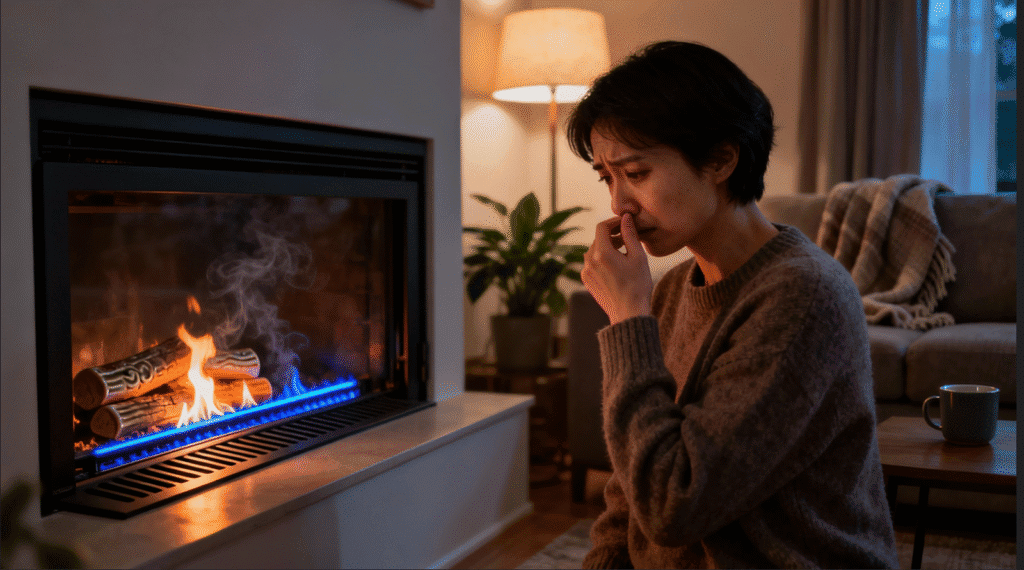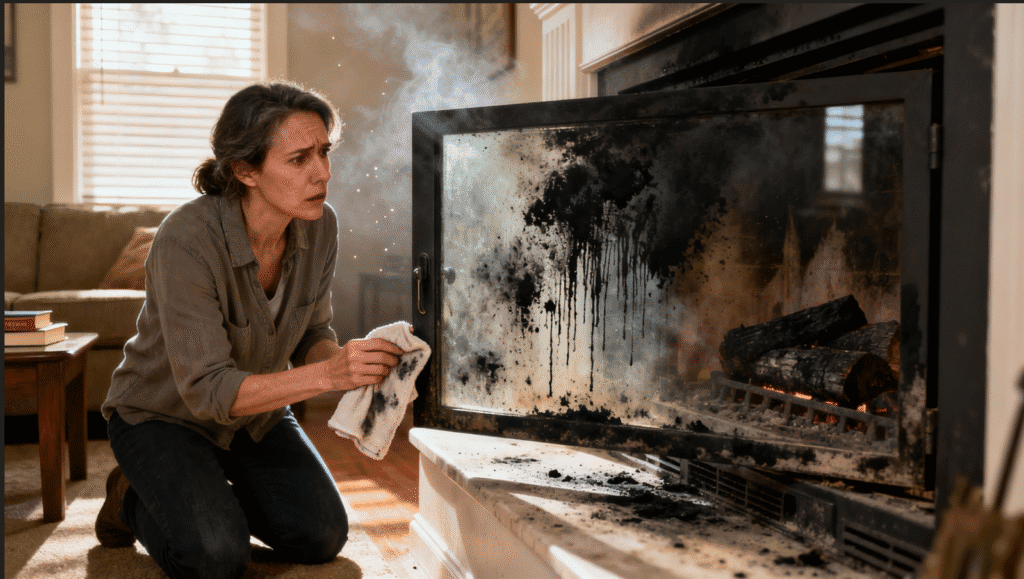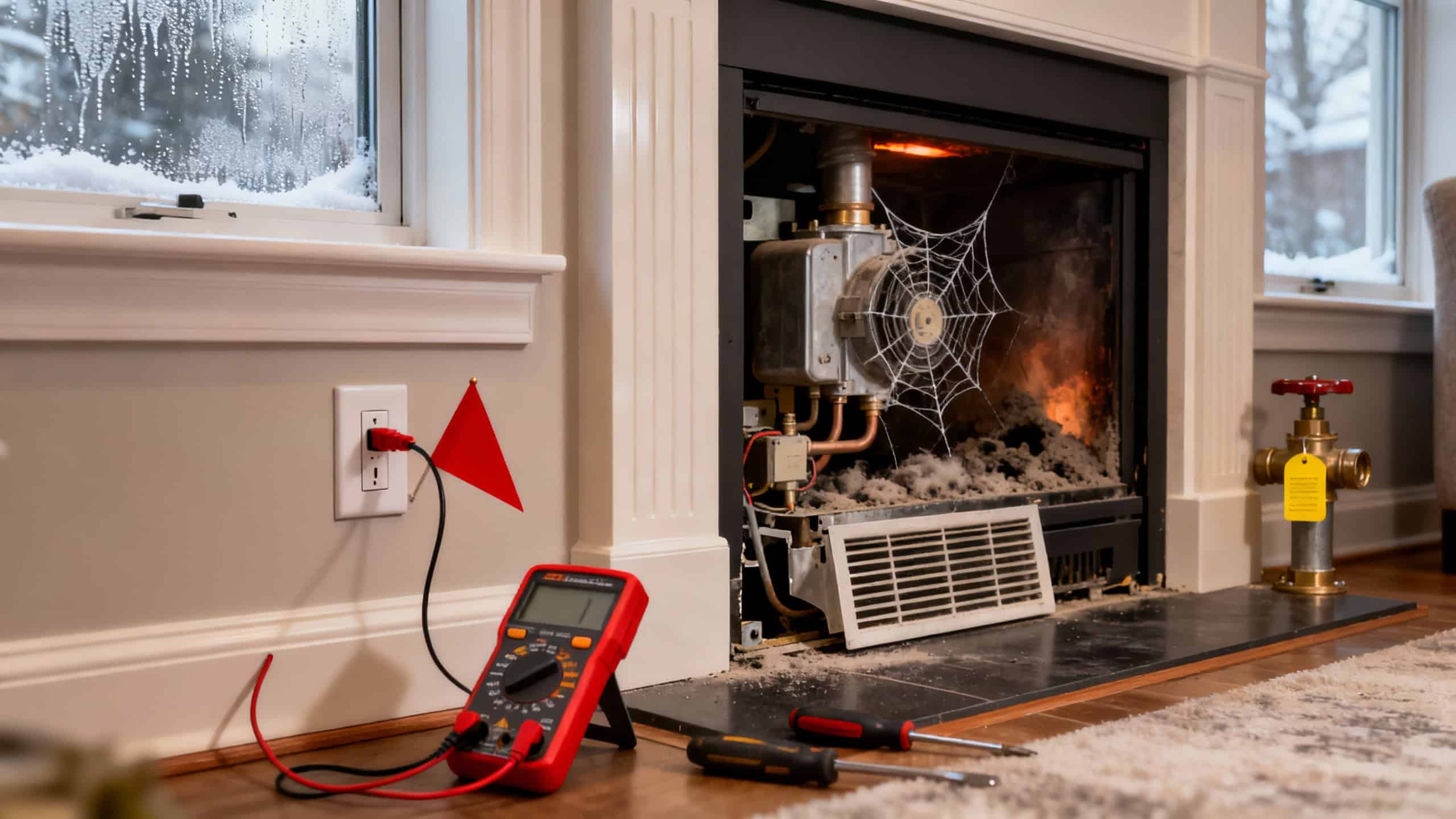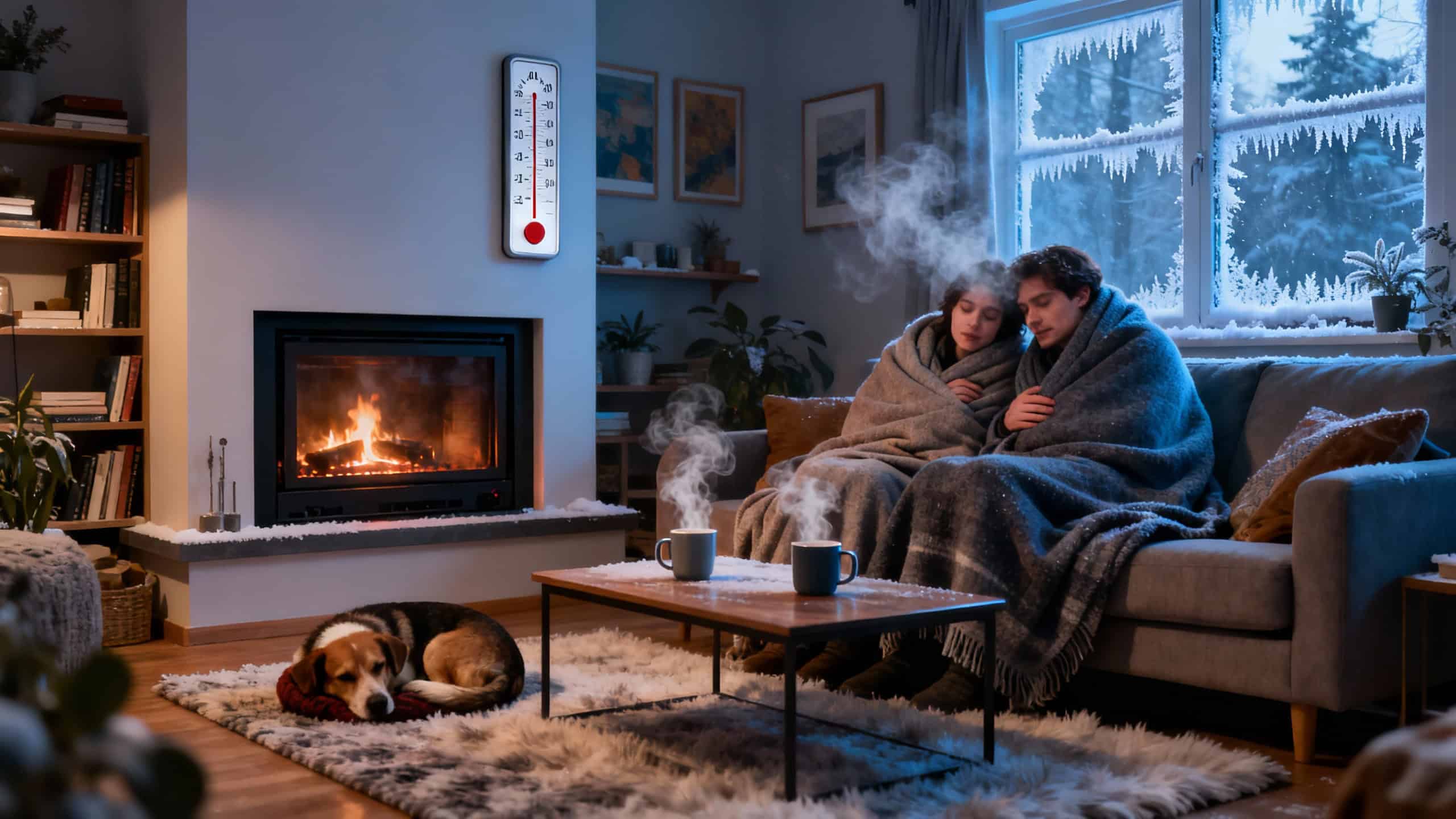A gas fireplace that won’t turn on typically signals problems with the pilot light, thermocouple, or gas supply line.
Clicking sounds without ignition indicate faulty igniters or electrical issues, while difficulty maintaining flame suggests clogged burner ports or pressure irregularities.
Strange odours, excessive soot buildup, and weak heat output also point to ventilation blockages or incomplete combustion requiring immediate attention.
Regular professional inspections identify these mechanical failures before they worsen, ensuring safe operation throughout winter. Understanding these warning signs helps homeowners determine when expert servicing becomes essential for restoring reliable performance.
Fast Facts
- Faulty thermocouples, clogged pilot assemblies, or gas pressure irregularities prevent the fireplace from lighting or maintaining flame.
- Malfunctioning thermostats or corroded wiring disrupt the startup sequence, stopping the fireplace from turning on properly.
- Continuous clicking sounds indicate an ignition system or electrical issues that prevent successful fireplace operation.
- Dust and debris on burner assemblies restrict flame intensity, causing the fireplace to fail or produce weak heat.
- Blocked exhaust vents trap heat and prevent proper airflow, interfering with the fireplace’s ability to start and operate.
Unusual Odours When You Start the Fireplace

A faint smell during the first fire of the season is normal, but strong or persistent odours signal a problem that requires immediate attention.
Gas leaks produce a distinctive sulphur or rotten egg smell and pose serious safety risks. Dust accumulation on burners can create a burning odour when heated. Soot buildup may emit acrid smells that worsen over time.
A professional fireplace safety inspection identifies the source of unusual odours before they escalate. Regular fireplace maintenance prevents hazardous conditions and ensures proper ventilation.
It’s also important to remember that malfunctioning fireplaces can pose serious safety risks, including the release of carbon monoxide, an odorless gas that can be deadly if inhaled in large amounts.
To ensure proper inspection and repair, always hire TSSA-licensed technicians who are certified to work safely with gas appliances.
Difficulty Lighting or Maintaining the Flame

Struggling to light your gas fireplace or watching the flame die repeatedly indicates underlying mechanical or fuel supply problems that need prompt attention.
Common culprits include faulty thermocouples, clogged pilot assemblies, or gas pressure irregularities that prevent consistent ignition. A malfunctioning thermostat or corroded wiring can likewise disrupt the startup sequence.
Regular fireplace maintenance helps prevent these issues by keeping igniters clean and sensors functioning properly.
When lighting problems persist despite troubleshooting, professional fireplace repair and cleaning become necessary. Licensed technicians diagnose valve malfunctions, gas line restrictions, and electronic control failures that require specialized tools and expertise to resolve safely.
Professional installation and repair services ensure thorough testing for gas leaks and proper functionality of all safety systems before returning your fireplace to operation.
If your gas fireplace won’t turn on, check simple factors first—like thermostat settings, wall switches, or dead remote batteries.
Sometimes, control modules or wiring faults are the real culprits. While basic troubleshooting can help, certified repair ensures your fireplace operates safely and efficiently.
Excessive Soot or Smoke Buildup

Black residue coating the glass doors or dark particles accumulating around the fireplace opening signal incomplete combustion that threatens both air quality and system efficiency.
Poor ventilation or blocked flues prevent proper exhaust flow, causing soot to settle inside the home instead of venting outdoors. Gas mixtures burning incorrectly create excess carbon deposits that reduce heat output and create respiratory hazards.
Homeowners should schedule professional fireplace maintenance services when noticing persistent buildup.
Regular fireplace maintenance includes cleaning burners, inspecting venting systems, and adjusting gas-air ratios to restore clean, efficient operation without harmful emissions.
A weak or dirty pilot light can cause recurring ignition failures. Regular cleaning and inspection keep the flame steady and ensure the fireplace lights properly every time.
Strange Noises or Clicking Sounds
When homeowners hear clicking, popping, or banging from their gas fireplace, these sounds typically indicate mechanical failures within the ignition system or damaged gas valve components.
Continuous clicking suggests the igniter is struggling to light the burner due to electrical issues or sensor misalignment. Popping noises often result from debris in the burner ports, causing irregular gas flow.
Banging sounds may signal expanding metal parts or pressure imbalances in the gas line.
Professional fireplace servicing identifies these underlying problems before they worsen. Following a comprehensive gas fireplace maintenance checklist ensures technicians inspect all mechanical components and restore safe, quiet operation.
Weak Heat Output or Uneven Heating
Noticing insufficient warmth from a gas fireplace indicates problems with the burner assembly, blocked venting, or worn-out components that prevent proper heat distribution throughout the room. Several factors contribute to reduced heating performance:
- Dust and debris accumulation on burner ports restricts flame intensity
- Dirty or misaligned thermocouples fail to regulate gas flow properly
- Blocked exhaust vents trap heat instead of circulating it effectively
- Aging blower motors struggle to distribute warm air throughout the space
Regular fireplace maintenance prevents these issues from developing. Following a gas fireplace maintenance checklist annually ensures optimal performance.
Professionals recommend servicing how often to service a fireplace how often—typically once per year, before winter begins.
Regular maintenance not only uncovers small problems early for manageable fixes but also enhances energy efficiency, leading to reduced utility bills.
Cracks in the Fireplace or Glass Door
Visible cracks in a gas fireplace’s ceramic logs, firebox panels, or glass door compromise both safety and heating efficiency, potentially allowing dangerous gas leaks or carbon monoxide to enter the living space. Even hairline fractures warrant immediate professional inspection, as thermal expansion during operation can rapidly worsen structural damage.
| Component | Safety Risk | Action Required |
|---|---|---|
| Glass Door | Gas exposure | Immediate replacement |
| Firebox Panel | Heat loss | Professional sealing |
| Ceramic Logs | Poor combustion | Expert evaluation |
Homeowners should never operate cracked fireplaces. Licensed technicians can assess whether repairs or full component replacement are necessary to restore safe operation.
Persistent Smoke Smell Even After Use
A lingering smoke odour hours or days after shutting down a gas fireplace signals improper ventilation or backdrafting issues that compromise indoor air quality. This smell indicates combustion byproducts remain trapped inside the home instead of venting outside properly.
Common causes include:
- A Blocked Chimney Or Flue is preventing smoke from escaping completely
- Damaged Chimney Liner allowing fumes to seep into living spaces
- Negative Air Pressure pulling exhaust back down the chimney
- Clogged Venting System restricting proper airflow and combustion
Professional cleaning and inspection eliminate these hazards.
TSSA-licensed technicians identify ventilation problems and restore safe operation before dangerous gases accumulate indoors.
The Benefits of Annual Fireplace Maintenance
Regular professional servicing prevents the types of problems that cause smoke smells, ignition failures, and safety hazards.
Annual maintenance catches small issues before they become expensive repairs, saving homeowners hundreds of dollars in emergency service calls.
Technicians clean burners, check gas connections, inspect venting systems, and verify carbon monoxide detectors during routine visits.
These tune-ups typically cost between $150 and $250 but extend fireplace lifespan by years.
Properly maintained gas fireplaces operate more efficiently, reducing monthly heating bills while ensuring family safety.
Scheduling service before winter guarantees reliable warmth when needed most.
Homeowners across the GTA trust ALP Heating for expert gas fireplace service, annual maintenance, and same-day repairs performed by licensed technicians.
Why Choose ALP Heating for Fireplace Servicing in the GTA
Over 200 five-star reviews across Google and HomeStars demonstrate why homeowners throughout Vaughan and the Greater Toronto Area trust ALP Heating for gas fireplace service.
The company’s TSSA-licensed technicians bring expertise to every inspection and repair call.
ALP Heating Delivers Reliable Fireplace Servicing Through:
- Same or next-day service for urgent heating issues
- Licensed professionals trained in gas appliance safety
- BBB accreditation and multiple HomeStars awards
- Service coverage across Vaughan, Toronto, Richmond Hill, and Maple
Family-owned since 2019, ALP Heating prioritizes customer safety and system efficiency.
Our technicians identify problems quickly and provide lasting solutions.
When troubleshooting fails, it’s best to rely on professional fireplace repair. Certified technicians ensure your system is cleaned, inspected, and restored to safe, efficient operation before winter arrives.








